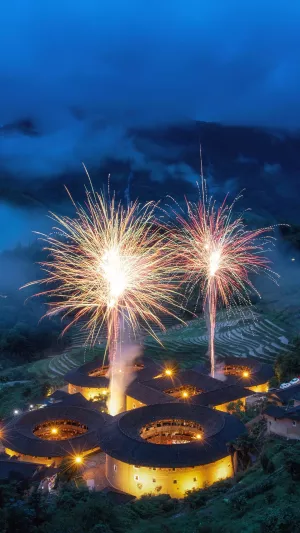Fireworks mark celebrations all over the world today, bringing joy and excitement to various festivities. From their origins in ancient China to their widespread use globally, fireworks have undergone significant changes.
The earliest fireworks, simple devices using gunpowder, could only produce a "pop” sound upon exploding. However, modern fireworks can create intricate shapes and vibrant colours, dazzling spectators and enhancing the atmosphere of celebrations.
On New Year's Day, people around the world set off fireworks to celebrate and illuminate the night sky with colourful displays. Fireworks are a traditional folk art in China, with their origins shrouded in mystery. Historical records suggest that the earliest mention of fireworks can be traced back to the Song Dynasty (from 960 to 1279). Fireworks are celebrated for their excellent visual effects, combining sound, color, fire, and smoke to create a sensory spectacle. These four elements are essential for a successful fireworks display.
When fireworks ascend into the sky, they produce a symphony of sounds, a burst of colours, and a shower of sparks, all contributing to their unique charm. The vibrant colours of fireworks are achieved by adding specific metal inorganic salts or metal powders to the gunpowder. These metal atoms undergo flame-color reactions at high temperatures, typically above 100 degrees Celsius, to produce various hues.
For example, aluminium-magnesium alloys burn with a dazzling white light, strontium nitrate and lithium produce red light, sodium nitrate yields yellow light, and barium nitrate creates green light.
Colourants play a crucial role in producing the beautiful colors seen in fireworks. These substances are the main agents responsible for the vivid display. When combined with luminescent agents and burned by combustion agents, they produce the stunning colors that decorate the night sky. The interplay of these chemicals creates the most beautiful scenery during a fireworks show.
Different sounds from fireworks are created by controlling the shape of the firework tube and the chemicals inside. Various chemicals react differently, producing a range of sound effects. Slow chemical reactions result in vibration sound effects, as the fireworks chemicals respond more slowly to high temperatures. On the other hand, rapid chemical reactions cause an immediate change from solid to gas, producing explosive sounds. This results in the shock waves that create the characteristic "bang" of fireworks.
In recent years, due to safety and environmental concerns, the ingredients used in fireworks have become more diverse and sophisticated, moving away from traditional materials. However, despite advancements, fireworks still pose environmental and health risks. They contribute to air pollution and noise pollution, with significant impacts on human health.
The noise from fireworks can damage hearing and affect the cardiovascular system, leading to irritability and anxiety. It also disrupts sleep and contributes to fatigue. The environmental impact of fireworks includes the release of harmful chemicals into the atmosphere, which can affect air quality and contribute to pollution.
While fireworks remain a beloved part of celebrations, it is essential to consider their impact on health and the environment. Efforts to create safer and more environmentally friendly fireworks continue, aiming to preserve the joy and beauty of fireworks displays while minimizing their adverse effects.
As we continue to enjoy the spectacle of fireworks, it is crucial to balance their celebratory role with a mindful approach to their environmental and health impacts. Through innovation and responsible use, we can ensure that fireworks remain a vibrant and safe part of our cultural celebrations.





